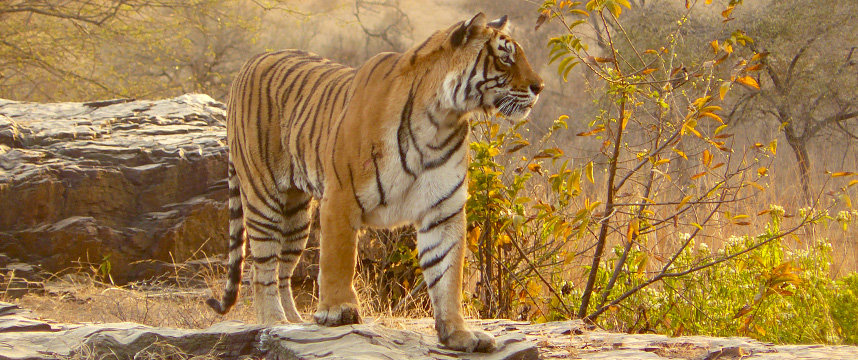Share this article
Wild Cam: What’s Killing India’s Tigers?
Surveillance and old-fashioned detective work are helping researchers track down suspects responsible for tiger losses in an Indian wildlife reserve.
“Tiger mortality isn’t totally related to natural events,” said Paul Krausman, a professor emeritus at the University of Arizona, former president of The Wildlife Society, and coauthor of a study published recently in the Wildlife Society Bulletin. Krausman and his coauthors made use of camera traps and intensive searches to determine several factors that contributed to Bengal tiger (Panthera tigris tigris) losses in the Ranthambhore Tiger Reserve in northern India from 2005 to 2011.
In our latest Wild Cam series, we look at camera trap photos and other images related to this study, which highlights some of the ongoing causes of tiger losses in this national park and points to trends behind overall decline of tiger populations across the country.
An estimated 50 tigers live within the tiger reserve. This dry deciduous forest ecosystem is important for tiger prey such as chital (Axis axis) and sambar (Rusa unicolor), according to Randeep Singh, the study’s lead author and an assistant professor at the Amity Institute of Wildlife Sciences in India.
The Ranthambhore Tiger Reserve sits in Rajasthan in northern India. The region is managed based on core zones, or critical habitats, which includes the Ranthambhore National Park, and a buffer zone where human activities are allowed, Singh said.
A female tiger successfully defended her cubs from a male tiger but died from injuries the day after the battle in 2009. “The postmortem report confirmed that the animal died due to deep canine injuries in her skull and neck,” Singh said. He and the other researchers confirmed that 12 tigers died within the study period while two tigers dispersed from the park. Five tigers were killed by human activities — two by poisoning and three found dead in wells. Krausman said that he suspects the ones found in wells were cubs, and may have been thrown there by villagers. The fate of another eight couldn’t be determined.
Prime tiger habitat near Padam Talab lake, which Singh calls “the lifeline of Ranthambhore.” The buildings represent the entry to the park and they house rangers and guards who monitor for tigers and for any illegal activities like poaching.
At the ripe old age of 18, one of the oldest tigresses of Ranthambhore carries off a recently killed chital fawn. The study showed that most tigers die before this age based on depradation (often as cubs or young tigers) or through natural causes like age or disease. This tigress is seemingly unconcerned about the paparazzi, representing the approximately 1 million tourists who come to the national park every year. “Ranthambhore is one of the favorite destinations of tourists and professional photographers for sighting tigers in free ranging conditions,” Singh said.
Singh measures a young female tiger being fitted with a radio collar by other researchers. Unlike some of the tigers that turned up dead, this one has given birth to two litters of cubs to date, Singh said.
Leopards are almost half the size of tigers but they share much of the same ecology, have similar behavior and compete for much of the same prey. Due to their smaller size, tigers will occasionally kill and eat leopards, Singh says.
Singh sets up a camera trap. The tiger reserves in India are “monitored like crazy,” according to Krausman. Despite some killing in the villages, “India is very protective of their tigers,” he said. Aside from the researchers’ work, this monitoring includes guards as well as public reports of tiger sightings and tracks. “It’s pretty comprehensive information.” But despite this close watch, Krausman said that poaching is becoming an issue and could explain the fate of the eight tigers that vanished from the reserve without a trace in the study period. “It used to be that they would be taken for their skulls and their hides but now it’s pretty much medicinal,” he said.
Krausman said that the study shows some of the challenges that lie ahead for tiger conservation. The reserve is surrounded by dense human populations, but as deer and other tiger prey expand and move out of the protected areas, the tigers sometimes follow them. This can result in nasty outcomes for people and ultimately for the tigers themselves. One of the ways to protect tiger populations into the future, he said, involves continuing to maintain these protected habitats from human encroachment.
“If they want to continue to maintain tigers, they are going to have to maintain tiger habitat,” he said.
This photo essay is part of an ongoing series from The Wildlife Society featuring photos and video images of wildlife taken with camera traps and other equipment. Check out other entries in the series here. If you’re working on an interesting camera trap research project and have photos you’d like to share, email Joshua at jlearn@wildlife.org.
















